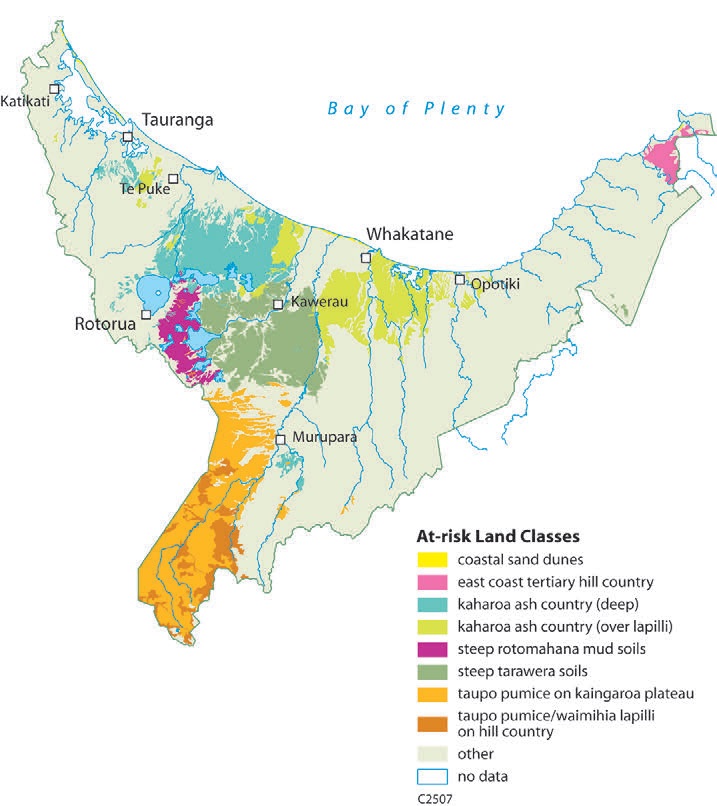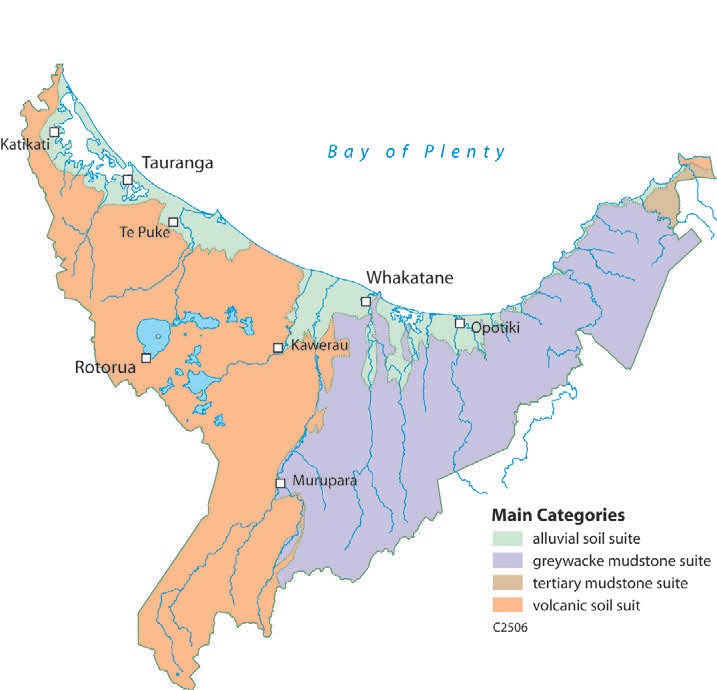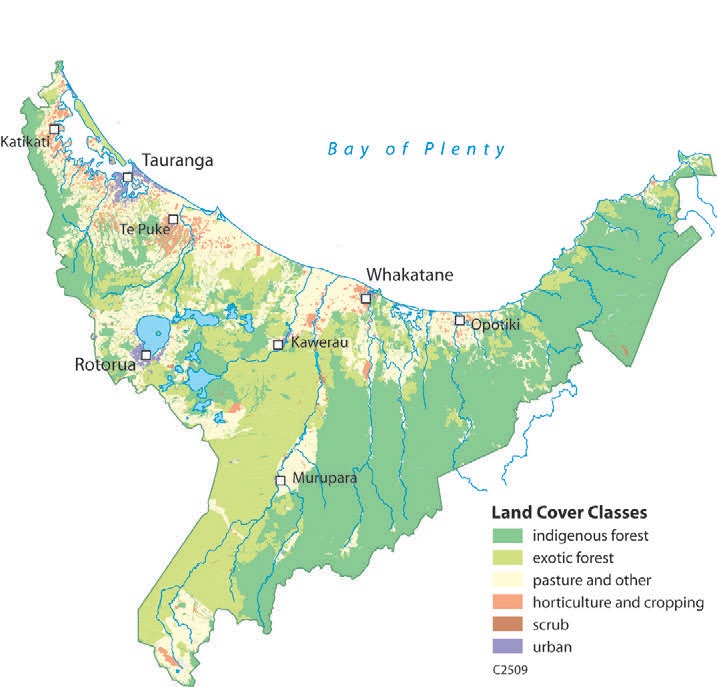The Bay of Plenty region
John Douglas, New Zealand Tree Grower May 2011.
The Bay of Plenty region covers approximately 21,836 square kilometres of which 12,250 square kilometres are land and the remaining area is coastal marine. The region extends roughly from Katikati in the west to Cape Runaway in the east, and Rotorua District and parts of the Taupo District in the south.
Climate, geology and landforms
The region’s annual rainfall ranges from about 1,200 mm at the coast to over 2,000 mm inland at higher elevations, but decreases again in inland basins such as near Murupara. Over 45 per cent of the annual rainfall is recorded in the months from May to August.
The driest period is from November to February. Winter is generally the wettest and summer the driest part of the year. Days with more than a millimetre of rainfall range from around 110 a year at the coast to around 130 inland at Minginui Forest.
The Bay of Plenty is somewhat sheltered from prevailing winds by the high country of the North Island. As a result, the region has a sunny climate with dry spells but may have prolonged periods of heavy rainfall.
The base geology of the western and central Bay of Plenty is quite different from the eastern Bay of Plenty.The western part is predominantly volcanic in origin, ranging from hard-welded volcanic rock to softer ones. The landforms reflect their volcanic origins and range from ignimbrite plateau country such as Mamaku, Whakamarama, Kaingaroa, to the steep Kaimai Range, and include the Rotorua Lakes and geothermal areas.
The geology of the eastern Bay of Plenty is dominated by the steep greywacke hill country in the Ureweras including the Kaimanawa, Ikawhenua, Huiarau and Raukumara ranges. Spilling into the headwaters of the eastern Bay of Plenty is the influence of the east coast geology dominated by mudstones. The steep greywacke country is relatively stable as long as the land cover remains intact. However, the tertiary mudstones are potentially the most erodible farmland in the world. Compounding this is the fact that this hill country is often relatively easy topography and very fertile.

Soils
Overlying the entire region and softening much of the landscape are a series of tephra deposits dating back over 120,000 years, but heavily influencing the soils formed in the last 10,000 years. This has resulted in ash soils over much of the region. The deeper ash soils occur in the western and central Bay of Plenty.
The alluvial soils on the plains and coastal fringes are generally formed from water-sorted tephra deposits. Shallower ash soils occur on the steep greywacke in the eastern Bay of Plenty. With a few exceptions, many of the region’s soils are light and friable. This makes them particularly susceptible to surface and river erosion processes. Leaching of nutrients is also an issue because of the sandy and freely draining nature of the soils.

The main soil classes and their distribution are shown in the table.
| New Zealand soil classification | General distribution |
|---|---|
| Allophanic | Western Bay of Plenty |
| Podzol | High country, wet, cool climate |
| Organic | Lowlands, wetlands, swamps |
| Pumice | Plateau and volcanic hill country |
| Recent | Around Lakes Rotomahana and Rerewhakaaitu and east coast |
| Gley | Rangitaiki Plains |
| Brown | Eastern Bay of Plenty greywacke hill country |
Land cover
| Land cover | Percentage |
|---|---|
| Indigenous forest | 45.2 |
| Exotic forest | 15.9 |
| Pasture | 34.8 |
| Horticulture | 1.3 |
| Urban | 0.8 |
| Lakes and rivers | 1.6 |
| Others | 0.4 |
Historically, the land cover in the Bay of Plenty has had a major influence on the resilience of the land to erosion. In particular, the forest land cover has helped reduce the risk of surface erosion to which the ash soils are prone.
Of greater importance, however, is the distribution of the land cover. Most of the indigenous forest vegetation is in the steep greywacke hill country in the eastern Bay of Plenty, the headwater catchments in the Kaimai ranges and coastal hill country, and the riparian margins of streams.

Land Use Capability
The Land Use Capability (LUC) classification of a piece of land is an expression of its long term-potential for sustained production. The New Zealand LUC classification consists of eight major classes of land ranging from 1 through to 8.
| Land Use Capability class | Percentage |
|---|---|
| 1 | 0.2 |
| 2 | 4.3 |
| 3 | 5.9 |
| 4 | 15.7 |
| 5 | 0.1 |
| 6 | 23.0 |
| 7 | 32.2 |
Class 1 land has very few limitations and has the capability to sustain a wide range of potential land uses. Class 8 land has little or no inherent productive potential and is normally used for catchment protection and recreational purposes. Classes 1 to 4 are arable while Classes 5 to 8 are non-arable. As you go from Class 1 through to Class 8 the land becomes less versatile and presents more hazards and physical limitaions.
The area of arable land, particularly Classes 1 and 2, is limited and therefore versatile land in the Bay of Plenty is limited. This combined percentage of Classes 1 and 2 at 4.5 per cent is close to the amount of highly versatile land in New Zealand of about 5.5 per cent. The importance of matching land use with land use capability cannot be overemphasised.
John Douglas works for the Bay of Plenty Regional Council

 Farm Forestry New Zealand
Farm Forestry New Zealand